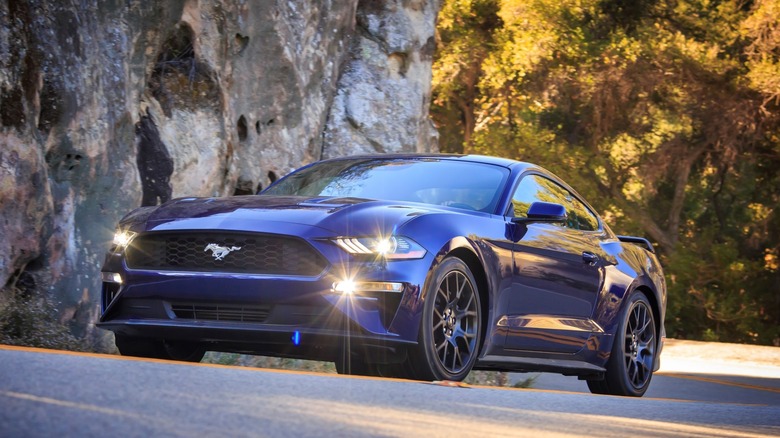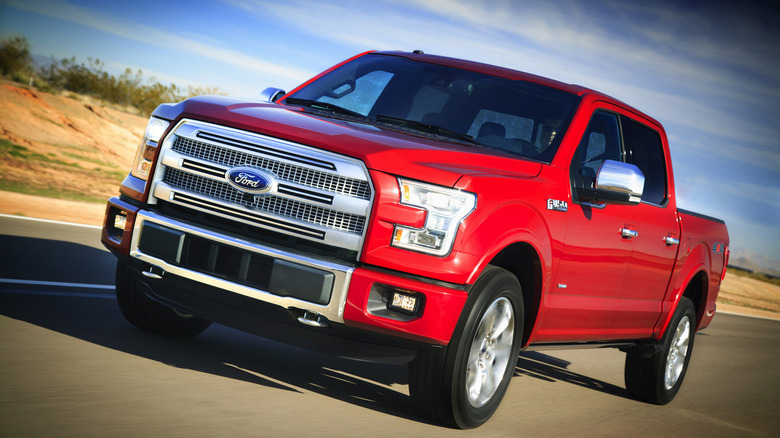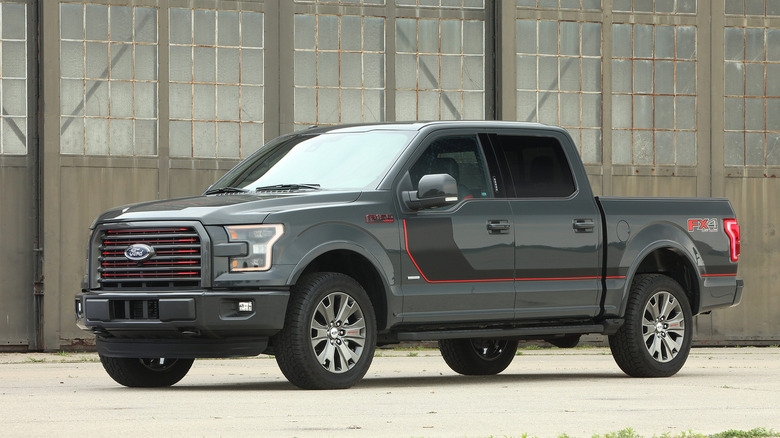How Reliable Is Ford's 5.0 Coyote Engine? Here's What Owners Say
Ford's Coyote 5.0-liter V8 boasts an outstanding reputation, well-known for its simplicity, power, and modularity. It's a reputation that it earned on its own merit, rather than simply deriving it from the shared "Five Point Oh" nickname it shared with the 302 Windsor that preceded it.
This uniquely long and storied history, with the continuous unbroken V8 production, helped establish a highly refined and purposeful design with the Coyote and its many derivatives, each of which has their own strengths and weaknesses. There are a few commonalities between all of them, however — they're all fairly powerful, robust V8s, for one. More importantly, they're all quite reliable.
There are two main applications for the Coyote across four distinct generations, namely Ford trucks and Mustangs. These can be further divided into individual powerplants based on performance and displacement, such as the 5.2-liter Voodoo, Predator, and Carnivore supercharged variants fitted to the Shelby and Raptor models, and subtle changes throughout each generation, such as the Gen IV and so on. But for the sake of simplicity, let's stick with the most common model: the traditional 5.0L fitted to the standard F-150 and Mustang.
As a rule of thumb, many of these overbuilt, highly developed V8s are quite reliable, such as GM's 6.2L LS series and Chrysler's latest 6.4L Hemi variants, and the Coyote is no exception. As we'll see, owners praise this engine for many factors, reliability included; aside from early engines and teething issues, there are very few complaints regarding the Coyote's longevity. Let's take a look at some exceptional examples and any particularly problematic designs to get a full picture of this powerplant.
The good points about the Coyote's reliability
Given its status as one of the best V8s of all time, almost everyone online generally praises the Coyote's good power and longevity, and its ability to last for six-figure distances with relative ease. This applies to both the F-150 and Mustang circles, with shops and experts in the field often recommending the engine for its durability, ease of maintenance, and ability to accept mild performance upgrades. Every generation of the Coyote is generally considered quite reliable, though some are naturally better than others. Moreover, there are a few differences between the truck and car variants.
That said, the car and truck variants of the Coyote both use much of the same internal components, meaning their reliability is largely identical. These include the same aluminum block castings, crank, conrods, and pistons. The majority of changes are to the peripherals — elements like exhaust, intake manifold runners, and so on, along with different cylinder firing orders.
The most substantial internal difference is the camshaft — the lobes on the truck variant are shaped for torque output, whereas the Mustang's are optimized for high-RPM horsepower. This means that their power bands are different, and they're likely to suffer different mechanical failures with varying upgrades, but as far as the base engines are concerned, neither configuration has any particularly egregious complaints.
As for mileage, owners typically report six-figure distances covered in both major configurations with a variety of generations, provided you do the maintenance, keep the power reasonable, and don't romp on the engine. These aren't 2JZ straight sixes that can just carry on with four-digit horsepower. Let's discuss these deficits in more detail.
The Coyote's downsides
The vast amount of comments against the 5.0's provenance focus on its need for continuous maintenance, especially in work applications or when adding more power. However, there are a couple of specific grievances related to the Coyote, generally attributed to the design of early models and various hidden faults. For example, early models were known to have improperly toleranced connecting rod bearings, the Gen III features a better fuel system and intake manifold than older variants, and so on. But of all of these discrepancies, the most stand-out appears to be the oil consumption problem.
The oil consumption became a known issue with these engines, so much so that Ford issued a notice stating that 5.0-equipped models suffer from about one quart of oil vanishing in about 3,000 miles of normal driving. Ford listed the reason as excessive intake vacuum pressure sucking oil into the combustion chamber when you let off the throttle, with the problem affecting specifically the Gen III Coyote, manufactured between 2018 and 2020. Other recalls are more incidental in nature, but they affect Coyote-equipped cars, such as the fuel pump failure recall of 2021-2023 model years.
Overall, though, these engines remain durable and easily-maintained despite these and other minor shortcomings. The oil consumption problem has since been rectified by mechanics and Ford techs, and owners continue piling on miles without any significant issues reported. Therefore, it's reasonable to state that the Coyote is among the most reliable engines fitted to American cars in general, and certainly among the most reliable V8s.
Our methodology
The Coyote V8 is an engine with multiple generations and configurations, ranging from mild to wild and everything in between. To get the most accurate and generalized assessment, therefore, we elected to focus on the most common baseline: The naturally-aspirated 5.0L, up to the Gen III configurations. We deliberately forewent studying the Gen IV model, because it's simply too new to have racked up a substantial amount of miles over enough time to determine its reliability accurately.
As for our sources, there are plentiful forums, expert testimonials, and mechanical breakdowns of the 5.0 Coyote available, which served as our primary references. Everything from major journalistic guides, magazines, and official bulletins to comments and individual posts were considered, helping create a more generalized picture of not just this engine's particular idiosyncrasies, but real-world data from long-term ownership.
We've deliberately stuck with engines in their factory configurations only, ignoring outside factors such as aftermarket systems, ad-hoc fixes for any issues, or other extraneous data, focusing instead on the actual internals of the engine as it came in the showroom. This perspective both ensures a level of impartiality and transparency for a customer looking to buy a bone-stock used F-150, for instance.



